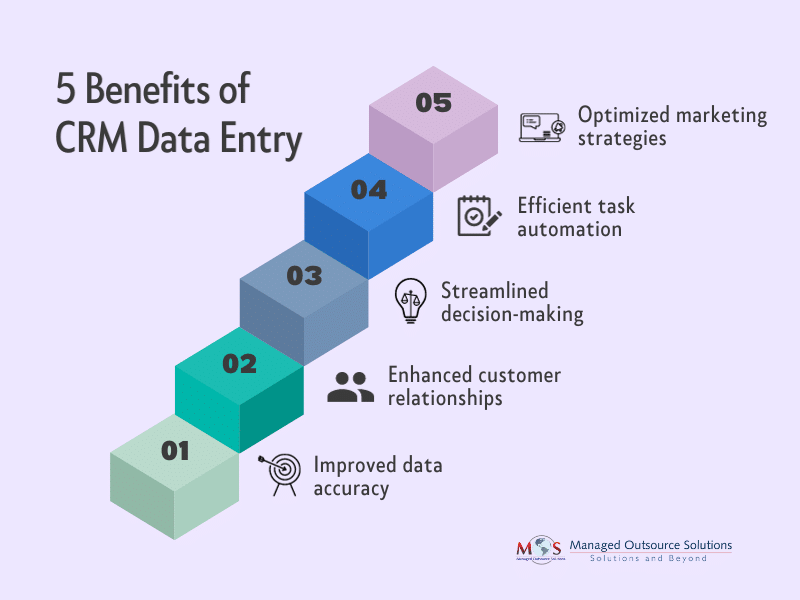Utilizing advanced CRM software, businesses can comprehensively summarize data, formulate effective strategies, and automate tasks. The CRM data entry process involves the input of customer details into a dedicated system, leading to enhanced management of relationships, lead monitoring, and improved effectiveness in sales, marketing, and customer service activities. Companies providing professional CRM data entry services employ diverse strategies including data extraction, database cleanup, anomaly detection, CRM migration support, and data formatting to optimize marketing automation and customer interaction.
Accurate CRM data provides more precise customer profiles, ensuring your sales team offers a personalized selling experience and builds relationships. For example, the Ecommerce industry effectively uses CRM’s analytics to categorize customers by preferences, buying behavior, and demographics, allowing their marketing teams to craft personalized campaigns with targeted promotions and product recommendations for each segment.
Best Practices for Seamless CRM Entry
Here are five best practices for efficient CRM data entry:
- Regulate data entry protocols:
To maintain an organized CRM database, steadiness is key. It is crucial for the data entry team to establish clear and standardized protocols, covering important aspects such as – contact details, lead sources, and categorization. This practice reduces errors, boosts data accuracy, and confirms uniformity across the system. Establishing clear rules ensures that all team members adhere to a set of guidelines when entering data, contributing to a unified and organized database.
For example, clear and standardized protocols for CRM data entry in a retail business is to use a standardized format for entering phone numbers to ensure consistency. Instead of variations like (555) 123-4567, 555-123-4567, and 555.123.4567, adopt a uniform format such as +1 (555) 123-4567.
- Provide user training:
Invest in comprehensive training programs for your data entry team. Equip them with a deep understanding of the CRM system’s features and the importance of accurate input. Training offers a multitude of benefits, starting with improved efficiency and accuracy in data entry. Well-trained personnel are more likely to adhere to best practices, reducing the risk of errors. User training also enhances the understanding of the system’s features, allowing for the usage of advanced functionalities that contribute to a more streamlined data entry process.
- Implement automation for repetitive tasks:
Automating repetitive tasks can enhance efficiency and reduce the likelihood of human error to a great extent. The first step is to identify areas where automation can be applied, such as lead assignment, and implement tools or features within your CRM system. The use of application programming interfaces (APIs) can help boost communication between the CRM system and other relevant tools, thus automating the data transfer process across platforms.
In a sales CRM, leads generated through various channels (website forms, social media, events) are automatically assigned to respective sales representatives based on predefined criteria such as geographical location or product interest. Here, automation ensures leads are promptly distributed, minimizing response time and avoiding the risk of human oversight in lead allocation.
- Regularly audit and cleanse data:
Data quality degrades over time, and redundant or obsolete information can clutter your CRM. Schedule regular audits to identify and rectify discrepancies. The process involves establishing audit schedules, identifying key data points, running data quality reports, addressing duplicate entries, reviewing historical data, and educating teams on data quality. Implement cleansing procedures to ensure your database remains up-to-date, relevant, and aligned with the evolving needs of your business.
- Encourage user feedback and collaboration:
Users who use the CRM system daily often have valuable insights into its strengths and weaknesses. Key strategies to foster a culture of engagement and collaboration include creating open channels for communication, regularly seeking input, acknowledging and appreciating contributions, implementing user-friendly interfaces, encouraging cross-departmental collaboration, and setting up a user advisory group.
By following these best practices, organizations make the most use of their CRM systems, which leads to enhanced customer relationships, informed decision-making, and sustained growth. Efficient CRM data entry directly influences the success of customer-centric operations. Accurate data is important for generating precise analytics and reports, enabling businesses to assess performance, identify trends, and make informed business decisions. Professional data entry companies can provide the right support for businesses to meet their CRM data management needs.
Connect to MOS for expert data entry services!





